Most organizations know where they want to go, but bridging the gap between vision and daily execution is the real challenge. When strategy isn’t clearly connected to everyday work, teams lose focus and resources are wasted on efforts that don’t drive results.
Strategic planning models solve this by giving you a clear, repeatable framework for setting goals, analyzing your position, and building an actionable plan. This guide breaks down the most effective models — like SWOT and OKRs— so you can choose the right fit and make strategy part of your team’s daily workflow.
Try monday work managementKey takeaways
- Pick strategic planning models that fit your specific goals, company size, industry, and needs — not just what’s popular.
- Link everyday work to strategic objectives to close the execution gap. Teams are more engaged and effective when they see how their work supports broader company goals.
- Be ready to change your approach when it stops delivering results. Signs like market disruption, rapid growth, or stagnant performance mean it’s time to reconsider your current model.
- Effective implementation goes beyond picking a framework. Engage stakeholders early, communicate directly, and celebrate achievements to build momentum and drive adoption.
- Streamline planning efforts with templates and real-time tracking. Automated workflows and shared dashboards in monday work management keep strategic initiatives visible and teams aligned throughout execution.
What is strategic planning, and what are strategic planning models?
Strategic planning is the process of defining your organization’s direction, setting priorities, and allocating resources to achieve both short- and long-term objectives. At its core, it’s about turning vision into actionable steps that guide decision-making and keep everyone aligned on common goals.
Strategic planning models provide the structured methods to make that happen. They act as blueprints, offering step-by-step approaches for setting goals, analyzing your position, and building actionable roadmaps. By breaking complex strategy into manageable pieces, these models help teams move systematically from ideas to strategic execution.
Core elements of strategic planning models
While each model looks different, most share the same fundamental building blocks:
- Goal setting: Define where you want the organization to go.
- Situational analysis: Assess where you currently stand in the market.
- Strategy formulation: Bridge the gap between today’s reality and desired outcomes.
- Implementation structure: Translate plans into specific actions, owners, and timelines.
These elements create the foundation for consistent, repeatable planning.
Why organizations need strategic planning models
Without a structured model, teams often drift in conflicting directions. Projects overlap, priorities shift, and resources are wasted on efforts that don’t drive results. A strategic planning model eliminates this chaos by providing a clear framework for decision-making, accountability, and adaptation when circumstances change.
Key benefits include:
- Optimized resource management so teams focus on what matters most
- Early risk identification for proactive problem-solving
- Stronger alignment across departments and leadership levels
- Measurable progress tracking that holds everyone accountable
Strategic planning models vs. frameworks
While often used interchangeably, models and frameworks serve different purposes.
| Aspect | Strategic Planning Models | Strategic Planning Frameworks |
|---|---|---|
| Definition | Comprehensive methodologies that guide the entire planning process | Narrow analytical tools that support specific stepsin planning |
| Examples | Balanced Scorecard, OKRs, Hoshin Kanri | SWOT, Porter’s Five Forces, PEST |
| Scope | End-to-end: goal setting → execution → measurement | Focused: market analysis, resource evaluation, competitive positioning |
| Best used for | Holistic, organization-wide planning, annual cycles, or major strategic shifts | Answering focused questions within a broader model |
| Integration | Can incorporate multiple frameworks as part of the process | Often used within a model to provide deeper analysis |
In practice, organizations often combine them. For example, a Balanced Scorecard model might incorporate a SWOT analysis for situational assessment or Porter’s Five Forces for competitive evaluation.
How to choose the right strategic planning model
There’s no one-size-fits-all. The right model depends on your organization’s size, resources, and strategic objectives. First, assess your needs:
- Organizational maturity: Are your planning processes still developing, or already sophisticated?
- Industry dynamics: Is your market stable or rapidly changing?
- Resource availability: Do you have the time, budget, and expertise for a complex methodology?
- Complexity factors: How many departments, stakeholders, or moving parts must be aligned?
Then, match your goals to models. Finally, apply these 5 selection criteria:
- Time horizon: Do you need short-term agility or multi-year planning?
- Scalability: Can the model grow with your organization?
- Industry fit: Does it account for your sector’s challenges?
- Implementation complexity: Can your team realistically adopt it?
- Measurement capabilities: How will you track and report progress?
20 strategic planning models that transform organizations
These 20 strategic planning models — along with supporting frameworks — give you a practical toolkit for setting direction, making decisions, and driving execution. Each brings unique strengths depending on your goals, industry, and stage of growth.
1. SWOT analysis

SWOT analysis helps you take a clear look at your Strengths, Weaknesses, Opportunities, and Threats, giving you a holistic view of where your organization stands. Instead of abstract strategy, it brings focus by highlighting what you do well, where you can improve, and which external critical success factors could impact your project.
Because it’s straightforward and visual, SWOT is often the first step teams take before diving into more detailed planning or analysis.
2. Balanced scorecard
The Balanced Scorecard turns big-picture strategy into actionable goals across 4 key areas: Financial, Customer, Internal Process, and Learning & Growth. Instead of just tracking financial numbers, this model gives you a holistic view — helping you balance short-term wins with long-term growth.
A software company may use the Balanced Scorecard to set financial goals for revenue, customer objectives to boost satisfaction scores, process targets to speed up product releases, and learning goals to invest in employee training. This way, teams stay aligned on what matters most and can see how their daily work moves the company forward on all fronts.
3. OKRs (objectives and key results)

OKRs (objectives and key results) provide a simple yet powerful way to keep everyone aligned on what matters most. By setting bold, inspiring objectives paired with measurable key results, teams gain clarity on where they’re headed and exactly how progress will be measured.
OKRs work especially well for fast-growing companies that need agility and transparency. With OKR templates and tracking tools, teams can connect high-level business objectives directly to daily tasks, making progress visible to everyone and keeping strategic goals front and center in everyday work.
4. Porter’s Five Forces
Porter’s Five Forces is a go-to tool for understanding the forces shaping your industry’s competitive landscape. It looks at 5 key areas:
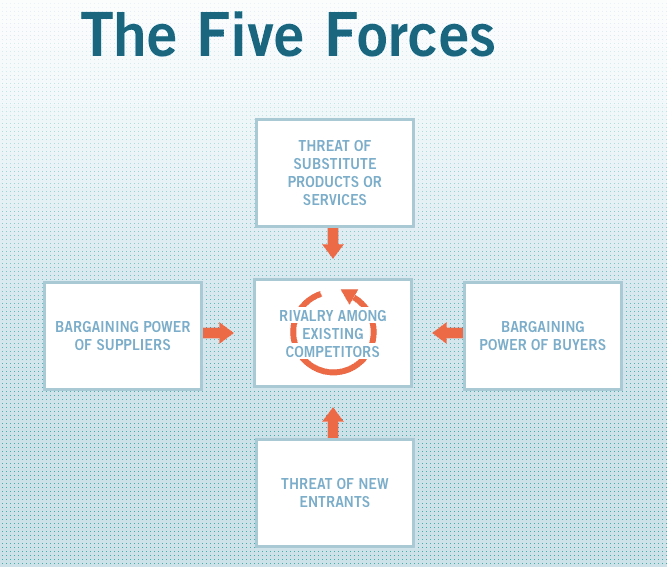
For example, if your team is considering launching a new SaaS platform, you’d use this framework to assess how easy it is for new tech startups to enter the space, whether there are alternative solutions customers might choose, and how much power suppliers or large enterprise buyers might have in negotiations.
5. PEST analysis
PEST analysis helps you scan the big-picture forces — political, economic, social, and technological — that shape your business environment. Instead of looking only at what’s happening inside your company, this model encourages you to step back and spot trends, risks, or opportunities that could impact your direction.
For example, imagine a retail brand planning to expand into a new international market. Using PEST, the team might uncover new government regulations (political), shifts in consumer spending habits (economic), changing cultural preferences (social), or a wave of e-commerce adoption (technological).
6. Blue Ocean strategy
Blue Ocean Strategy is all about finding opportunities where there’s little to no competition — think creating your own lane instead of battling it out in crowded markets. By focusing on innovation and what makes you truly unique, this approach helps organizations uncover needs that competitors haven’t even considered yet.
For example, imagine a fitness company noticing that most gyms compete on equipment and price. Instead, they launch a subscription-based virtual wellness platform that combines live classes, nutrition coaching, and community support, opening up an entirely new market.
7. Ansoff matrix
The Ansoff Matrix is a straightforward, visual tool that helps you map out your growth options using a simple 2×2 grid:
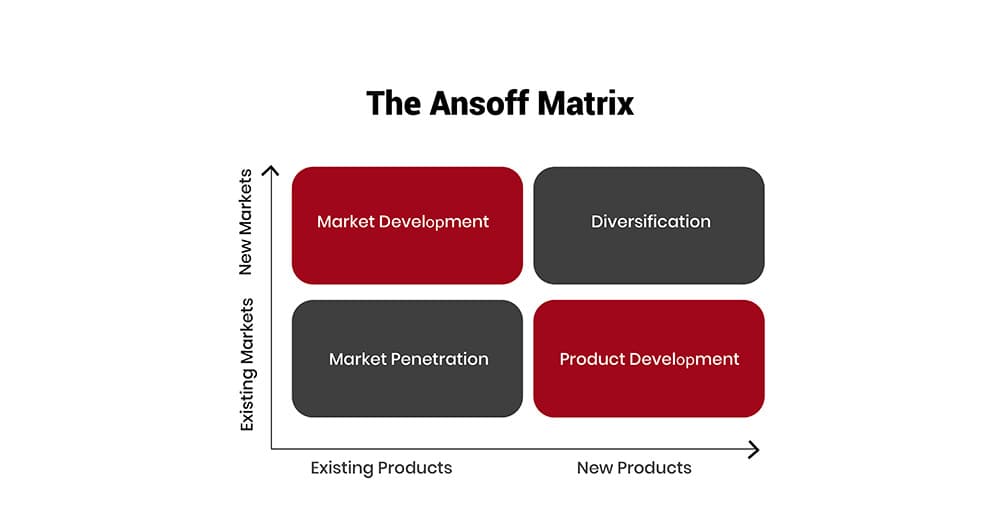
Say you’re leading a food company with a strong local presence. The Ansoff Matrix can help you decide whether to double down on your current market by running a loyalty campaign (market penetration), introduce a new snack line for your loyal customers (product development), start selling your products in neighboring cities (market development), or launch a completely new product — like health drinks —in a new region (diversification).
8. McKinsey 7S model
The McKinsey 7S Model examines 7 interconnected elements — strategy, structure, systems, shared values, style, staff, and skills — to ensure every part of the organization supports its goals. It’s especially useful for major transformations or culture change, where alignment across all areas is critical. Use the McKinsey 7S Model when you’re driving organizational transformation or culture change.
9. VRIO framework
The VRIO framework is a powerful tool for evaluating your organization’s resources and capabilities across 4 critical dimensions: Valuable, Rare, Inimitable, and Organized.
For example, imagine a SaaS company with proprietary AI technology. VRIO helps the team assess whether this technology is not just valuable (driving customer outcomes), but also rare (few competitors have it), difficult to imitate (protected by patents or expertise), and well-organized (integrated into operations and supported by the right processes). If all 4 criteria are met, the company has a sustainable competitive advantage it can confidently invest in and scale.
10. Hoshin kanri
Hoshin Kanri is a Japanese strategic planning approach that creates alignment between an organization’s long-term vision and the daily actions needed to achieve breakthrough results. It provides a structured, step-by-step process for cascading high-level objectives down to every department and team, ensuring that everyone is rowing in the same direction. At its core, Hoshin Kanri emphasizes continuous improvement, regular progress reviews, and transparent communication.
This approach is especially effective for organizations seeking operational excellence and a culture where everyone is engaged in achieving big-picture goals through systematic action.
11. Gap planning
Gap planning is all about identifying where you are today versus where you want to be, then mapping a clear path to close that space. Instead of guessing what needs improvement, this model gives you a structured way to analyze current performance, compare it to your goals, and prioritize the areas that will have the biggest impact.
This approach is especially valuable when your main objective is performance improvement. It’s frequently used in operational planning or to develop new capabilities within your team or organization. By turning improvement into a step-by-step process, gap planning makes it easier to track progress, adjust tactics, and ultimately achieve your desired outcomes.
12. Scenario planning
Scenario planning is a strategic approach that helps organizations anticipate a range of possible futures by developing detailed “what if” scenarios. Instead of relying on a single forecast, you outline several plausible situations then map out how your organization would respond in each case.
This process encourages teams to think creatively about risks and opportunities, making it easier to spot hidden vulnerabilities and discover innovative paths forward. By proactively testing your strategy against a variety of futures, you can build robust contingency plans and ensure your team stays agile, no matter what tomorrow brings.
13. BCG matrix
The BCG Matrix is a popular strategic tool that visually maps your business units or products into 4 categories: Stars, Cash Cows, Question Marks, and Dogs.
| High Market Share | Low Market Share | |
|---|---|---|
| High Market Growth | Stars: High performers that need investment to keep growing | Question Marks: Potential opportunities that require strategic focus to determine if they can become Stars |
| Low Market Growth | Cash Cows: Reliable revenue generators that fund other ventures | Dogs: Low performers best considered for divestment or repositioning |
Consider a a consumer electronics company whose flagship smartphone might be a Star, demanding ongoing investment to stay ahead. An older, steady-selling laptop could be a Cash Cow, generating profit with minimal effort. A new wearable device might be a Question Mark — full of potential but still unproven in the market. Meanwhile, an outdated accessory line may be a Dog, potentially ready to phase out.
14. Value chain analysis
Value Chain Analysis is a strategic tool that breaks down your business’s core activities alongside supporting functions such as HR, technology, and procurement. The goal is to take a close look at each step in your value chain to uncover where you’re excelling, where bottlenecks exist, and where unique value or cost-saving opportunities might be hiding.
For example, a manufacturing company might use Value Chain Analysis to discover that its distribution process is more costly than competitors. By redesigning its logistics or partnering with a new shipping provider, the company can cut costs and deliver products faster.
15. Core competencies model
The Core Competencies Model helps organizations pinpoint and nurture the unique strengths that truly set them apart — those hard-to-replicate capabilities that deliver lasting value in the marketplace. By identifying these core competencies, companies create a strong foundation for their strategic planning, ensuring resources are invested where they’ll have the most impact. This approach is especially effective when you’re looking to secure long-term success, as it encourages teams to focus on what drives real differentiation and value for customers.
16. Strategic group mapping
Strategic group mapping is a visual tool that helps you plot competitors within your industry along key dimensions, such as price, product quality, or target customer segment, to reveal how different players are positioned in the market. By creating a map of these groups, you can quickly spot which areas are crowded, where gaps exist, and how various competitors cluster together.
This approach not only clarifies the broader competitive landscape, but also helps your team identify underserved customer segments and potential areas for meaningful differentiation.
17. Resource-based view
The Resource-Based View (RBV) focuses on harnessing your organization’s internal resources and capabilities as the foundation for building a lasting competitive advantage. Rather than looking outward first, this approach encourages you to look within to identify the unique strengths that set you apart from competitors and channeling investments to maximize their impact.
By zeroing in on what you do best, you can shape strategies that play to your strengths and build a more resilient, differentiated position in the market.
18. Stakeholder mapping
Stakeholder mapping is a strategic process for identifying and analyzing the individuals, groups, or organizations whose support is crucial for your plan to succeed. Rather than viewing stakeholders as an afterthought, this model places them at the center of your strategy, recognizing that true success hinges on understanding their interests, influence, and potential impact.
19. Kotter’s 8-step model

Kotter’s 8-Step Model is a widely respected approach for leading successful organizational change, with a special emphasis on the human factors that drive transformation. Rather than tackling change as a single event, this model guides you through 8 steps: create, build, form, enlist, enable, generate, sustain, and institute change.
Kotter’s model is especially effective for major transformations that require deep cultural change or widespread buy-in. By focusing on both process and people, it helps organizations move confidently from vision to sustained success.
20. North star metric
The North Star Metric is all about zeroing in on a single, meaningful metric that best reflects the core value your product or service delivers to customers. By rallying everyone around this one guiding measure, it brings clarity, unifies priorities, and ensures that every team knows exactly what success looks like.
The North Star Metric approach is especially powerful when you want to create alignment and momentum across fast-moving teams, and it’s a favorite among growth-stage companies looking to accelerate progress without losing sight of what matters most to customers.
When should you update your strategic planning model?
As your organization grows, your strategic planning approach should grow with you. What helped you move fast as a startup might slow you down at scale. If your planning cycles feel sluggish or teams can’t see how their work supports the bigger picture, it’s time to reassess.
Here are some signs you may need a new model:
- Industry shifts: New competitors or disruptive tech are changing the rules.
- Company growth: Your old model can’t handle your current size or complexity.
- New priorities: Your business focus has evolved, but your planning process hasn’t kept up.
- Stalled progress: You’re stuck on a plateau, and the current model isn’t delivering results.
But don’t overhaul everything overnight. Bring in new elements gradually and keep stakeholders in the loop about why change is needed. Also avoid switching models too often, failing to train your team, or neglecting to update processes can lead to confusion and resistance. Clear, ongoing communication is the key to success here.
Try monday work managementHow to implement strategic planning models that actually work
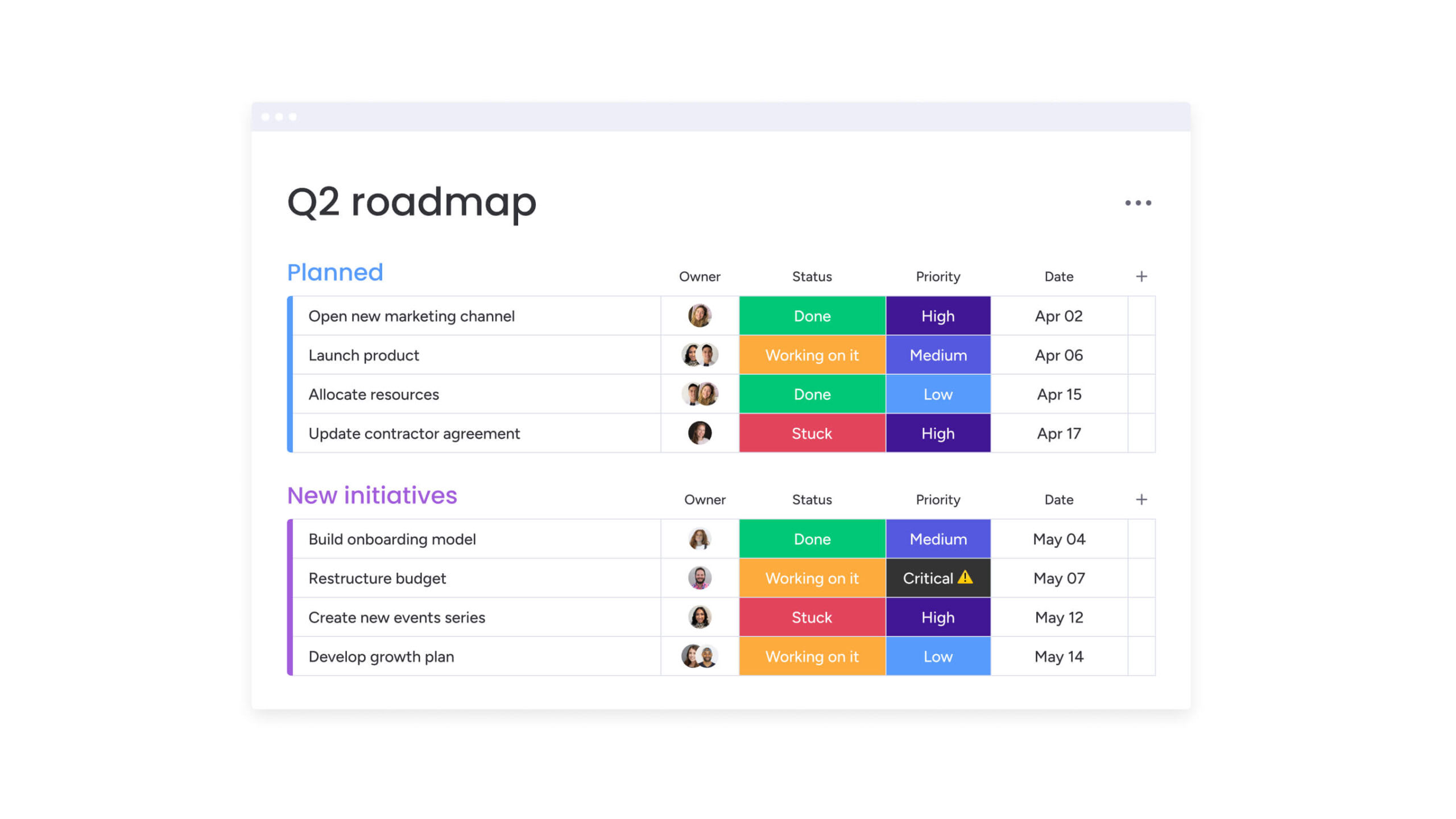
Putting a successful strategic planning model to work requires 3 key steps:
Step 1: Build a clear roadmap
- Timeline: Set phases and milestones that are realistic for your team.
- Resources: Assign budget and people where they’ll have the most impact.
- Communication: Keep everyone updated on progress and changes.
- Metrics: Decide how you’ll measure and report on success.
Step 2: Engage your teams early
Teams are more likely to buy in when they’re part of the process. Train them on new models, celebrate early wins, and use monday work management to support collaboration with shared dashboards, real-time updates, and built-in communication tools.
Step 3: Measure and adjust as you go
You can’t improve what you don’t measure. Track your objectives, spot bottlenecks, and adapt quickly. Employees who know how their success is measured are twice as likely to feel motivated, according to The world of work report by monday.com.
With the right software, you gain the visibility and reporting you need to keep strategy and execution connected.
Transform your strategic planning with monday work management
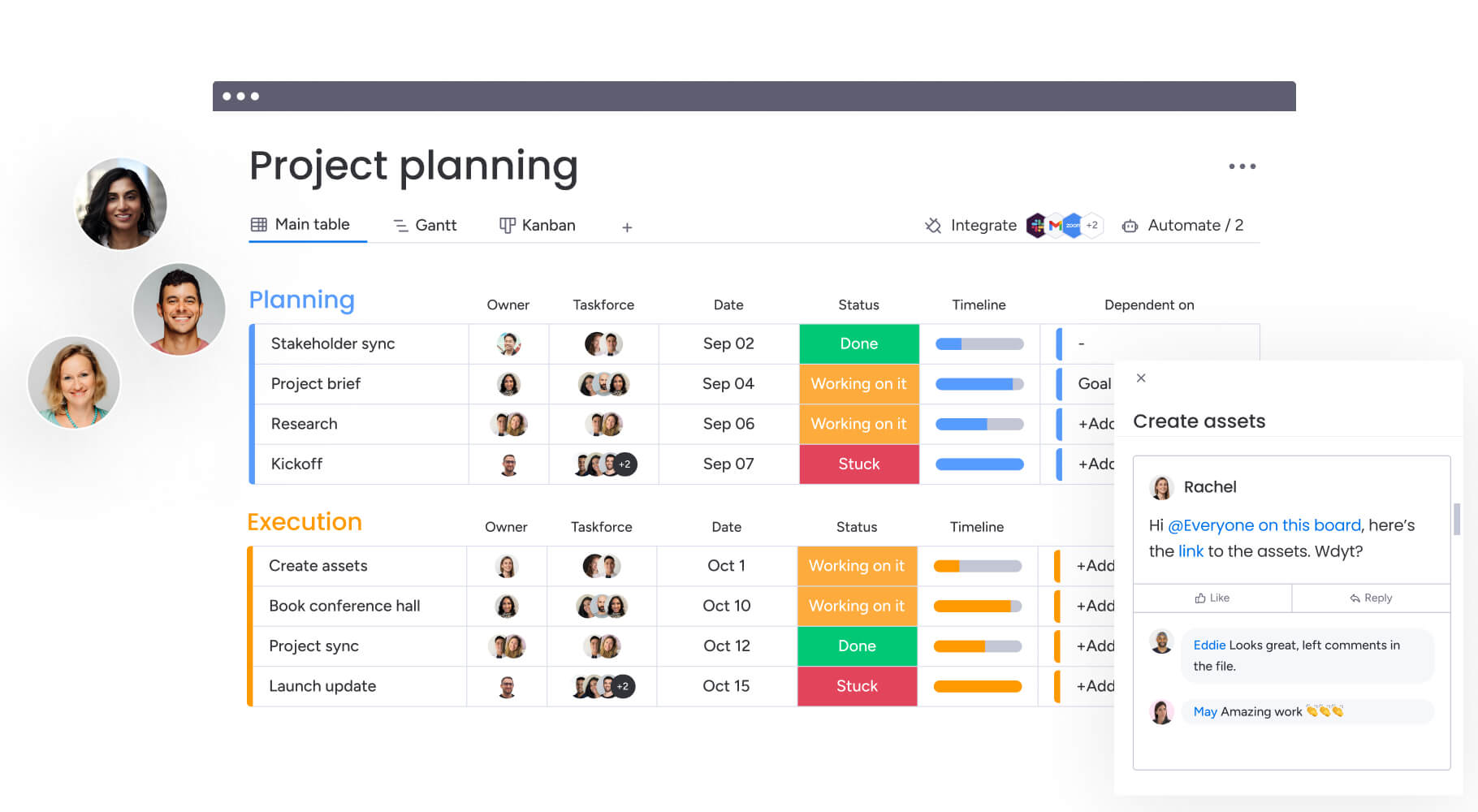
Choosing the right model is only the first step. With monday work management, you can connect strategy to execution with:
- AI-powered planning: Use AI Blocks to generate SWOTs, draft OKRs, summarize insights, and surface blockers in seconds.
- Seamless integrations: Connect Slack, Teams, Salesforce, Google Workspace, and more — all updates flow automatically.
- Customizable workflows: Automate recurring tasks, approvals, and KPI-based triggers to reduce manual work.
- Visual dashboards: Track KPIs, milestones, and team performance in real time, and share progress with leadership.
- Direct alignment : Link objectives to projects, tasks, and owners so every team member sees how their work supports top priorities.
To bridge the gap between planning and execution, use monday work management, and keep strategy visible, measurable, and actionable.
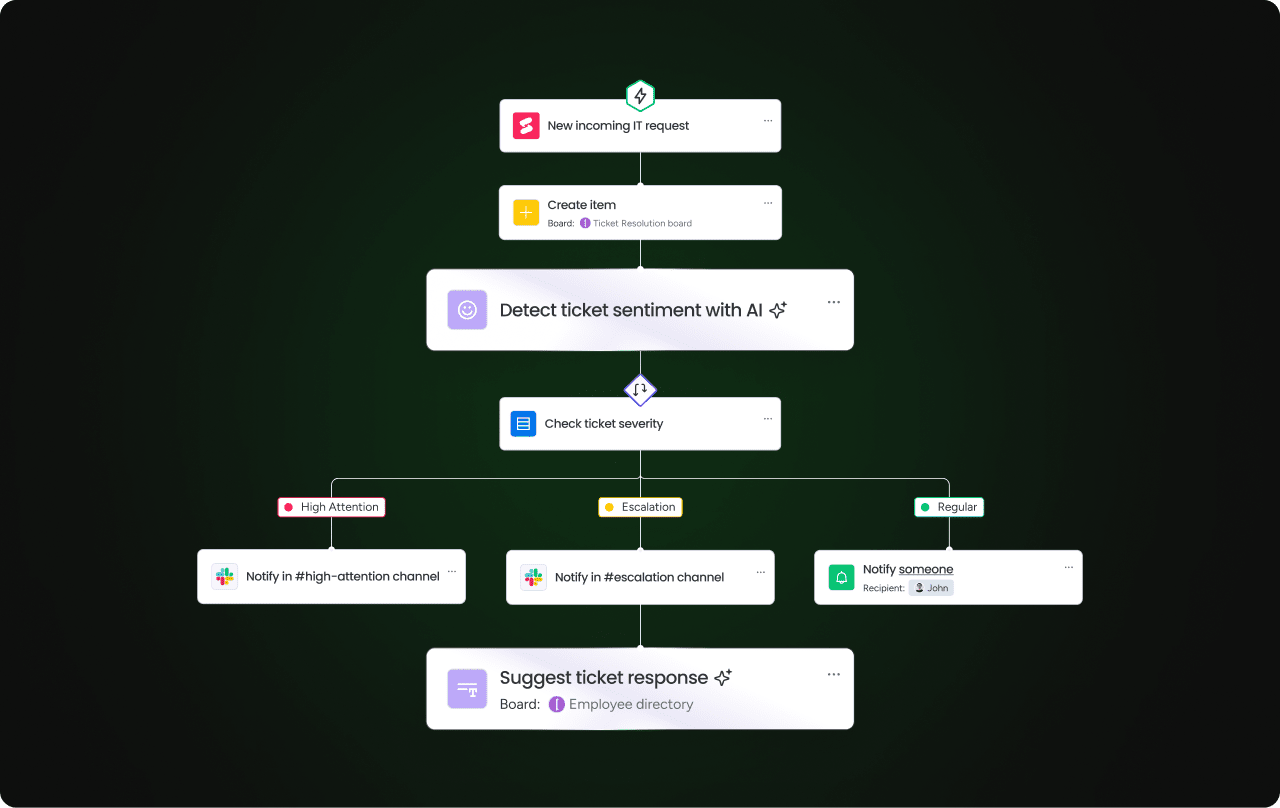
Take your strategic planning further
Choosing a strategic planning model is just the beginning — lasting results depend on translating that plan into clear, consistent action. With the right digital tools, you can use templates, automation, and real-time dashboards to keep everyone focused and accountable as you move from strategy to execution.
Reduce manual effort, increase team alignment, and ensure your strategic initiatives achieve real impact. Explore how work management software can support your planning process and make strategy a part of everyday work.
Try monday work managementFAQs
What is the difference between strategic planning models and strategic management?
The difference between strategic planning models and strategic management is that models are structured approaches for creating strategies, while strategic management encompasses implementing, monitoring, and adjusting those strategies over time. Planning focuses on developing the roadmap, while management covers ongoing execution and adaptation.
How long does it take to implement a strategic planning model?
The time it takes to implement a strategic planning model varies based on organizational size and model complexity. Simple models like SWOT analysis can be implemented in 3-4 weeks, while comprehensive approaches like Balanced Scorecard typically require 3-6 months for full deployment.
Can small businesses use the same strategic planning models as large enterprises?
Small businesses can use strategic planning models, but they often need simpler models that match their resources and complexity. While enterprises might use comprehensive Balanced Scorecard systems, small businesses typically succeed with streamlined approaches like basic OKRs or simplified SWOT analysis.
Which strategic planning model works best for rapid-growth companies?
Rapid-growth companies often benefit from OKRs or North Star Metric approaches. These models provide focus and flexibility while allowing for quick adjustments as market conditions change.
How often should organizations review and update their strategic planning approach?
Most organizations review their planning approach annually during regular planning cycles. Major model changes typically occur every 3-5 years or when significant business transformations require different planning methods.
What role does technology play in modern strategic planning models?
Technology platforms like monday work management enable real-time tracking, automated workflows, and collaborative planning. They transform static planning documents into dynamic systems that connect strategy to daily execution.
